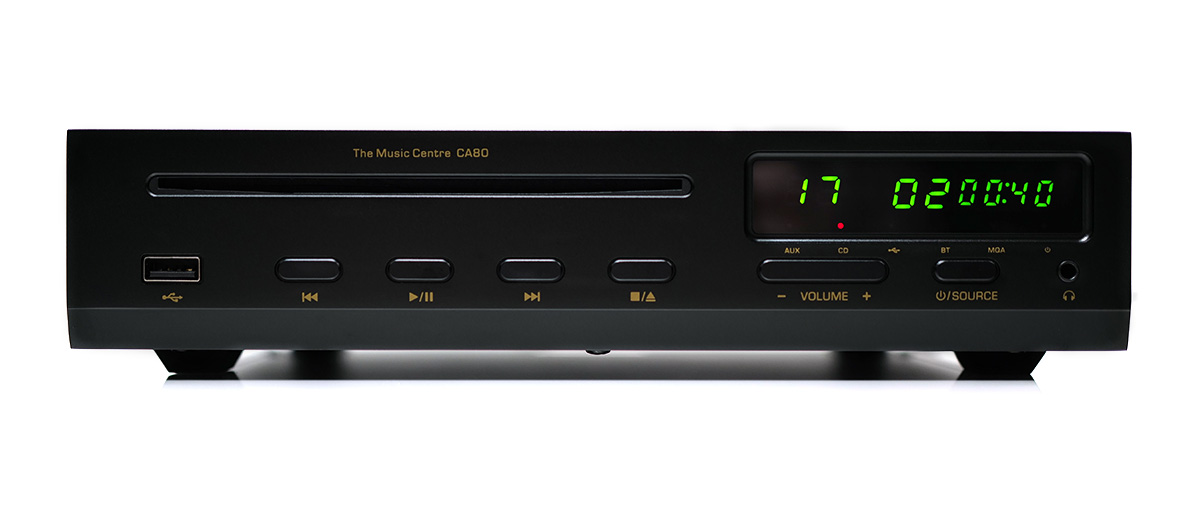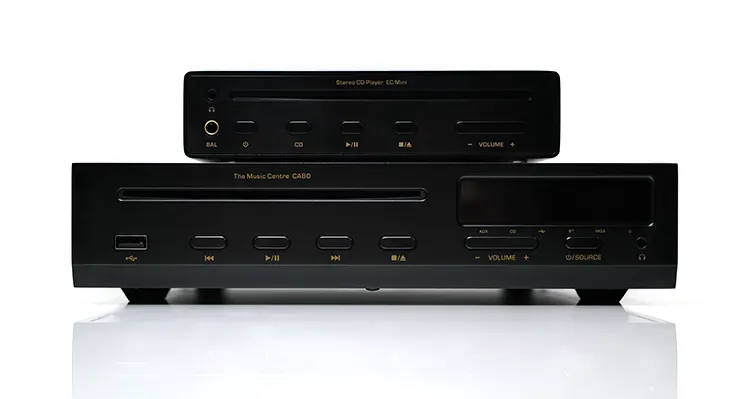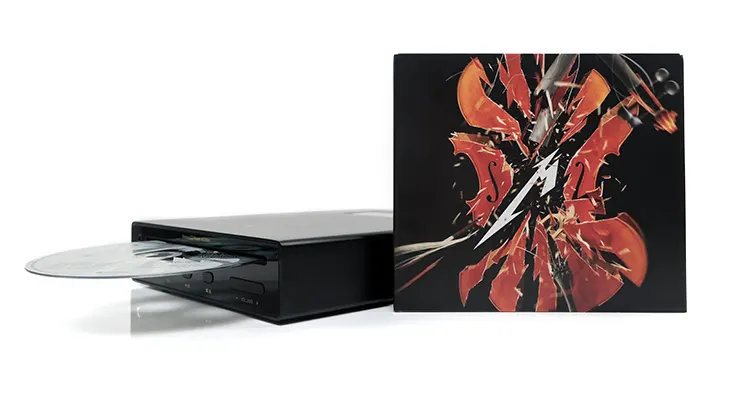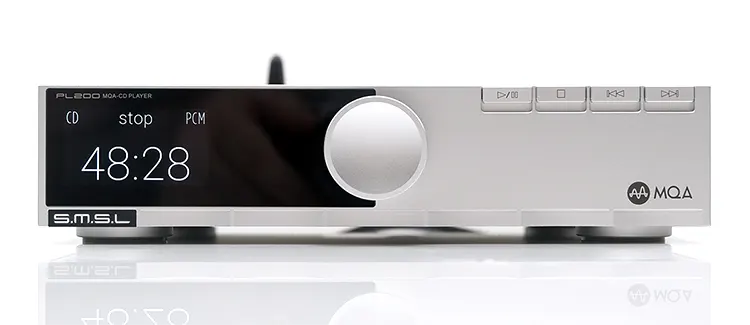Select Comparisons
The following comparisons to the Shanling CA80 were completed using a mix of the Campfire Audio Fathom, PMG Audio Apx, Vision Ears VE10, and the Austrian Audio Composer via an SE out to a Gustard H26 headphone amplifier.
Shanling EC-Mini
The Shanling EC-Mini was launched in Q3 2023 with our review published in March of this year.
The CA80 is priced higher than the EC Mini at $599. However, the CD80 version without the amplifier is much closer at $399. Therefore, this comparison will be based on the CA80 features without the speaker amplifier to give you a proper CD80 vs EC Mini comparison.
Technical
The CA80 (CD80) has some features that overlap with the EC Mini though the positioning is primarily desktop as opposed to portable with no batteries fitted and AC only.
They share the same slot-loading Philips CD tray with a Sanyo HD860 optical laser. However, the damping on the CA80 version is superior with a much quieter loading experience. Also, the CA80 reads the disc a split second faster than the EC Mini on first-time loading.
Both units can load digital media locally. The CA80 uses a USB-A slot for flash cards rather than microSD for the EC Mini. The CA80 also lacks the MTouch software and LCD screen for media management but I find its larger digital tube display more attractive.
Both devices are BT-capable and can SyncLink with Shanling’s Eddict App. From there you can manage the CA80’s local media files, quickly switch sources, control gain levels, and choose from one of two filter options.
What the CA80, (and the CD80), cannot do is BT transmit audio. It can only receive with any two-way interactions limited to SyncLink.
Both devices have headphone outputs. The CA80 only offers a single-ended connection with a maximum of 130mW under a 32Ω load. If you want balanced output the EC Mini is the better option with up to 240mW output on the same load.
The ES9219MQ DAC chipset is the same in both devices with similar decoding rates for local media at up to PCM 384kHz and native DSD256 with MQA unfolding. Both will receive up to LDAC for BT but only the EC Mini can transmit.
Design
The design language between these two is very similar, even if the form factor is essentially a ‘little and large’ show.
You can tell with ease both are designed by the same company with similar fonts, labeling color schemes, and a miniaturized version of the CA80, (CD80), front panel button scheme on the EC Mini.
The only substantive layout differences include the additional balanced output port, the MTouch software panel on the EC mini, and the more traditional large digital tube panel on the CA80, combined with a source selector button.
The EC Mini source selector is software-controlled via the MTouch panel with no ability to switch source from the Eddict app, something which can be done with the CA80, (and CD80).
The CA80 also ditches the microSD slot on the rear with a USB-A port for flash memory on the front which you can also manage directly through the Eddict app using BT in the same manner as the EC Mini.
The rear panel is quite different. Apart from the 4 speaker binding posts, the CA80 offers dual analog SE RCA I/O to receive 3rd party DACs and output to amplifiers and a traditional 24BIT/96kHz optical output for transport duties to an external DAC.
The EC Mini rear panel is busier to match its wider feature set. There is an additional bidirectional USB-C for USB-DAC input, OTG output, and the in-vehicle mode switch. It does not operate as a transport so there is no matching optical output.
Performance
Using the 3.5mm headphones output and the CD player of both units with the PMG Audio Apx and the Campfire Audio Fathom I heard some slight differences.
The first clear difference was the gain level of the EC Mini compared to the CA80, (CD80). The default gain on the main desktop unit sounds like the equivalent EC Mini’s high setting with the EC-Mini low gain softer sounding.
I suspect this is where the improved capacitor selection and upgraded power supply inside the CA80 makes a big difference.
The second difference was the dynamic range. The EC Mini sounds softer and not as well separated through the mids.
Neither is that different tonally, both aim for a smooth and rich timbral quality. Rather, the dynamic impact and immersive staging performance of the CA80 3.5mm output was the more impressive of the two outputs.
A/B’ing back and forth I found myself pushing the EC Mini volume progressively to try and match the more explosive sound of the CA80 but without much success or until it just became too loud.
There does seem to be more warmth from the EC Mini SE output and a generally more relaxed presentation which moves me a bit less.
The balanced output on the EC Mini is more competitive for dynamic range but even then there is more warmth through the upper mids and highs. The CA80 (CD80) has a more neutral tonal quality, with better treble energy and perceived clarity.
I also got the same feeling with digital media playback. The EC Mini sounded more relaxed, even when using a balanced output. The CA80, (CD80), delivers a tauter sound quality with more height and forwardness in its presentation.
SMSL PL200
The SMSL PL200 was released in late 2023 and we have it here for review in the coming weeks if not days. Some of my thoughts on this comparison may be tweaked in the forthcoming main review.
Technical
SMSL has gone the in-house route with their top-loading P.A.S.S. or Precision Access Servo System compared to the CA80’s branded Philips CD tray and a Sanyo HD860 optical laser.
Top loading is a simpler design with fewer moving parts and, if done well, is less likely to scratch or fail leaving your CD stuck in the tray. The downside is that it is not stackable, meaning you need space over the top panel to insert the CD.
My experience with the PL200 top loader is that it is fast to read, loading CDs perhaps 5-6 seconds faster than the CA80, even allowing for the puck and lid placement time.
Both units can operate as a DAC. However, the PL200 has no local storage USB mount, interfacing like a regular DAC to PC/MACs with a USB-C interface on the rear panel.
It also has a higher-end AKM AK4499EX DAC, decoding up to PCM 32BIT/768kHz and DSD512 via USB. The CA80’s ES9219MQ DAC delivers a lower PCM 32BIT/385kHz and native DSD256.
Both have BT5.0 modules up to LDAC though the CA80 lacks aptX. The key advantage of CA80 when going wireless is the Eddict app integration for both media and BT. This gives you more flexibility to place the player anywhere without a USB cable for media playback.
Both units offer amplification for IEMs and earphones but the PL200’s rear output 6.35mm design makes it clear this is a secondary option. It also has no direct-to-speaker amplification.
The CA80’s front panel 3.5mm TRS output placement is more accessible but much weaker at 130mW into 32Ω compared to 1W for the PL200.
The PL200 offers both SE and balanced variable and fixed lineout on the rear panel but I am presuming 2/4Vrms split as there is no voltage specification for either in the user manual.
Design
Both players have some beautiful retro styling though both have gone very different routes to achieve that look.
The SMSL is far smaller and lighter, making it a neat device to stack on top of a device whereas the CA80 is more the device to be stacked on top of. The top loader system though means the PL200 does need to be on top regardless.
The PL200 only comes in silver with no black option but I think it stands out much better in the silver format. Nuanced design accents might get lost in a black finish. The vintage black with the digital tube glow of the CA80 suits its vibe perfectly.
The SMSL styling is very noire to me with its thin tall font on a very legible IPS panel on the front combined with a two-tone finish on the front panel. I love the physical buttons on the right side, a genuine nod to an older era of mechanical buttons.
The physical buttons are also multifunction capable allowing you to change the various player modes, CD, DAC, and BT, thus further enhancing the player’s ease of use.
I also prefer the volume dial on the front of the PL200 as opposed to the manual rocker of the CA80. It’s faster to cycle through the volume levels with additional multifunction capability allowing you to dive deeper into the player’s extensive menu system to access tons of sound-shaping options.
Both units come with plastic but capable remote controls. My only critique is the same issue I mentioned on page 1 of this review, the CA80’s lack of track-select numbered buttons, a feature that the PL200 version offers.
Performance
The PL200 from both PO and LO leans more neutral and slightly brighter compared to the warmer, weightier coloration from the CA80.
That is not to say the CA80 is dark. Rather its strongest treble presence sits a little more on the lower mids whereas the general harmonic balance of the PL200 is lighter on the lows and stronger on the upper order.
This creates a perception of less note body, a lighter fundamental, and more contrast on instruments and vocal timbre from the PL200.
From the PO, the CA80 produced a natural fuller tone for me and was far more suited to classic rock and metal CDs, especially 80s rock CDs that I tend to find have a stronger digital sound.
Combined with heavier percussion presence and guitar mixes the presentation can ring bright and sharp on the PL200. The CA80 offered a more balanced and easy to listen to sound quality with better depth and vocal smoothness.
Gear matching here for the PO is more on the warm-side for IEMs with the PL200 such as the Fathom and the VE10 with more neutral IEMs such as the Apx finding a home with the CA80.
The PO of the PL200 did much better with the advantage of the balanced output creating a little bit more space and channel separation compared to the CA80’s more intimate imaging.
A smoother and warmer amplifier such as the Gustard H26 is a nice match with the PL200. You still do not have the same bass weight or strong vocal presence from the CA80 but the treble sounds more tempered and soothing with headphones such as the Austrian Audio Composer.
Cayin Mini-CD MK2
The Cayin Mini-CD MK2 was launched at the tail-end of 2022 and is the cheapest of the compared players in this lineup. It’s been a staple in my office setup for about 8 months as a personal purchase.
Technical
Of the three players, the Mini-CD MK2 is probably the one closest to what you would call a pure CD player. This is not a transport, it does have a DAC chipset, with an older ES9018Q2M that has a nice upsampling capability that does make a difference to the performance.
However, there is no amplification inside, there is no USB interface to receive an incoming signal from a digital source or a flash drive mount. This is purely a CD player with onboard decoding offering an analog SE 2V dual RCA and digital coaxial output.
There is, however, one additional feature on the Mini-CD MK2 that I wish the CA80 did have and that’s I²S output, allowing you to connect it up to a 3rd party DAC with a compatible I²S socket.
I have a lot of DACs here that work beautifully with the Mini-CD MK2’s I²S, taking advantage of that higher upsampling rate which optical outputs cannot match.
Like the CA80, the Mini-CD MK2 uses a slot-loading mechanism and a Sanyo laser. However, I have been less than impressed with the Mini-CD MK2 loading performance. Quite often the CD will slide in but fail to mount and be read forcing me to reboot and hit open right after to eject the CD.
That has not been the case with the CA80. In the few months I have used it not once as it failed to mount a CD and read it no matter what the room’s environmental condition was at the time.
Design
The Mini-CD MK2 has similar dimensions and form factor when stacked on top of the CA80. It is marginally lighter by 0.8kg at 2kg compared to 2.8kg and just a few mm more depth but otherwise a fair match.
The styling is quite different though you can choose the CA80 in silver which might produce a closer aesthetical match.
The Mini-CD MK2 reminds me of Arcam designs from the late 90s using an aluminum housing and a subtle brushed finish complete with compact chrome round buttons.
The only drawback is the rather plain housing finish on the main chassis behind the front panel with exposed screws. The CA80 looks much more complete with its finishing and less in the way of exposed screws.
The CA80 black is a nice contrast to the Mini-CD MK2 and arguably has an even more retro feel to its finish. The Mini-CD MK2’s dot matrix-style display is clean with decent albeit brief information during playback or upsampling but it lacks the ‘pop’ of the CA80s digital tube LCD panel.
Both have good spacing on the rear panel for their respective outputs but of course, the Cayin is missing those speaker binding posts that make the CA80 unique in this comparison lineup.
Performance
The Mini-CD MK2 is a fixed single-ended lineout player so I matched it and the CA80 with the Gustard H26 for testing along with the VE10 and the Composer.
With both packing Sabre chipsets, these two players are closer bedfellows tonally than the PL200. That being said, there is some differing emphasis on their imaging and soundstage properties.
The Mini-CD MK2 is more how I remember the ES9018Q2M from a few years back just a little more refined than some of the early engineering efforts. Imaging is more neutral on the lows, further forward on the mids, and slightly more energetic in the highs when compared to the CA80.
Shanling has tuned the CD80 for a warmer bass and more lower-mids prominence relative to the upper mids, pulling back the sparkle of the Mini-CD MK2 treble presence. Not by a huge amount, the Mini-CD MK2 is not as bright as the PL200 in that region, but it will stage a bit taller than the CA80.
The CA80 is more about depth, sounding more relaxed beyond. There seems a shade more bloom on the mid-bass and lower mids of the Composer and the VE10 via the H26 amplifier whereas the Mini-CD MK2 is flatter over the same region.
Vocal imaging on the CA80 fell away to the point where I found myself pushing up the volume to try and attain the same immediacy as the Mini-CD MK2.
I am a vocal guy so the impact imaging of singers is important to me. I would pick the CA80 if the tracks had no vocals for its smoother mids and beefier lows. You could consider it the marginally more forgiving of the two players for brighter recordings or headgear.
My Verdict
As a CD player, the Shanling CA80 delivers a reliable and pleasing performance with a bias to the smooth and natural side accompanied by excellent bass weight and a clean black background.
Its PO is better served with IEMs or efficient headphones with its capable lineout better equipped to service amplifiers that can handle more demanding gear.
It does lack some features other similarly priced modern CD players offer such as a balanced lineout option and a USB-C DAC interface though I dare say the speaker amplification option does mean it’s after a different audience.
The bonus is the USB-A local file system and the Eddict SyncLink system, a Shanling house specialty that gives an otherwise standalone and almost retro-like CD player experience a dash of audiophile modernity.
Shanling CA80 Technical Specifications
General
- Net weight: 2.8kg
- Consumption power: 20W
- Main Control: Junzheng X1000
- Decoding chip: ES9219MQ
- Bluetooth: BT 5.0
- Power supply: external AC100V-AC240V
- Display: Digital Tube Display
- Control method: APP+remote control+keys
- Enter: CD, U disk, Bluetooth, RCA
- Output method: RCA, optical fiber, 3.5mm headset
- Disk playback formats: DSD / DXD / APE / FLAC / ALAC / WAV / AIFF / AIF / DTS / MP3 / WMA / AAC / OGG / MP2 / M4A / AC3 / OPUS / TAK / Cue
Amp-Out output
- Output Power
- 50w@82Ω (0.3%)
- 100W@4Ω (0.3%)
- Frequency: 20Hz -20KHz (-0.2DB)
- THD+N: 0.003%
- Separation: 80db@32Ω
- Signal-to-noise ratio: 108 dB
PO Output
- Output power: 130MW@32Ω
- Frequency: 20Hz -40kHz (-0.2DB)
- THD+N: 0.0015%
- Separation: 75db@32Ω
- Dynamic range: 119 dB
- Signal ratio: 118 dB
- Output impedance: less than 1Ω
LO Output
- Output level: 2.0Vrms
- Frequency: 20Hz -40kHz (-0.2DB)
- THD+N: 0.002%
- Separation: 85 dB
- Signal ratio: 116 dB







